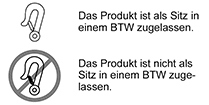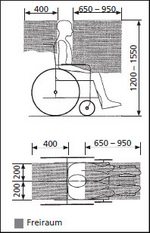Introduction
This page provides you with an overview of the measures that must be taken in order to minimize any risk associated with the conveyance in a transport vehicle of a person sitting in a wheelchair.* The wheelchairs listed in the chapter (wheelchairs authorized for the transport of people with disabilities) were developed in compliance with national and internationals standards; the integrated restraining devices increase the safety of wheelchair users during transport and in the event of a head-on collision.
You can find further information on transporting persons in wheelchairs in the user manual and in the safety and general handling notes included with each wheelchair.
Safety notes
- We advise against using the wheelchair as a seat during transport in a vehicle
- • Whenever possible, the seats installed in the transport vehicle as well as the corresponding safety systems must be used
- We cannot be held responsible in any way for physical restrictions of the users of our products in the event of a traffic accident
- If used correctly, safety and restraint systems are only capable of minimizing the risk of injury; however, they are not able to completely eliminate such a risk
- The safety of the person transported in the wheelchair depends to a considerable extent on the person responsible for transport. Make sure that this person has received proper training, is familiar with the applicable regulations and also complies with them. In particular, this person should be advised of possible risks
- Never use transport means that are not authorized for the transport of persons in wheelchairs
- In order for a wheelchair to be used as a seat in a vehicle, it must have special anchoring points. This is the only way to effectively secure the wheelchair in the transport vehicle. In some countries, these anchoring points may not be included in the standard delivery contents of the wheelchair; in such a case, customers have the option of ordering them from us
- Secure your wheelchair so as to rule out any risk of an accident involving the wheelchair should the transport vehicle perform dangerous manoeuvres
- No modifications may be made to the wheelchair or, in particular, the anchoring points
- The wheelchair must be secured in accordance with the user manual of the manufacturer of the four-point anchoring system
- Only four-point anchoring systems in accordance with ISO 10542-2 may be used
- The driver of the transport vehicle and/or the accompanying persons must ensure that the wheelchair is properly secured in the transport vehicle
- They must ensure that parts of the wheelchair do not cause the restraining device to loosen or detach in the event of an accident
- An accident involving the transport vehicle may damage the structure of the wheelchair. Wheelchairs transported during an accident must be inspected by a qualified workshop before being used further
Securing the wheelchair for transport
[Translate to English:]Depending on the location of the wheelchair in the transport vehicle, proceed as follows:
- Ensure electrical safety (in electrical vehicles).
- The regulations of the relevant transport company must be complied with in this respect. – Switch the electric car off. – Switch to driving mode (engage the drive).
- Stow the parts of the wheelchair that have been removed so that they are safe and protected.
- Use tension belts to secure the wheelchair.
- Attach the tension belts to the designated parts of the transport vehicle and wheelchair only.
- The anchoring points (4) of your wheelchair are each marked with the symbol (1).
- Refer to the user manual for your wheelchair to determine the position of these anchoring points.
- The belts for the anchoring system must be mounted within the shaded angle area towards the vehicle floor (2) (3). Larger angles are preferable.




The wheelchair must be used as a vehicle seat
The nameplate of your wheelchair indicates whether your individual wheelchair has been approved for transport in transport vehicles for people with disabilities. The following paragraphs apply if your wheelchair fulfils the requirements of ISO 7176-19 in connection with a four-point anchoring system in accordance with ISO 10542
- The wheelchair has undergone a crash test, for which it was anchored in the transport vehicle's direction of travel
- Other configurations were not tested
- The test dummy was restrained with pelvic and shoulder safety belts
- Both safety belt types should be used to minimize the risk of injury to the head and/or torso
Safety notes
- The wheelchair must be equipped with maintenance-free batteries (in the case of electric vehicles)
Attention: Restraint system hooks in accordance with the ISO 10542-2 standard must be used!
- Only transport the wheelchair in the direction of travel
- The accessibility of the storage area for restraining the wheelchair primarily depends on the dimensions and turning area of your wheelchair. The storage area for restraining the wheelchair is more accessible with smaller, more compact wheelchairs
- Refer to the technical data in the user manual for your wheelchair in this regard
Securing the wheelchair user
The safety belt in the wheelchair is in no way a substitute for safety belts attached to the vehicle.
Attention: ! Safety belts tested in accordance with ECE 16 must be used.!
- Angle-adjustable backrests must be moved to a vertical position
- Tilt-in seats must be moved to a level position
- Height-adjustable seats must be moved to the home position
- Height/angle-adjustable leg supports must be moved to the home position
- Untested equipment variations such as special controls or therapy tables can increase the risk of injury and, together with removable accessories, must be taken out of the hazardous area and stored in a safe manner
- Safety belts must be tightly fitted on the user's body. They must not be run over armrests or rear wheels (1).
- Safety belts should be as tight as possible without causing any discomfort to the user
- Safety belts must not be fitted if they are twisted
- The pelvic and shoulder belt should be fitted tightly and without obstruction between the user's pelvis and thigh (2)
- Make sure that no objects are strapped under the safety belt! – This will prevent any painful pressure points
- The three-point/shoulder belt should be fitted in the vehicle as shown in [3]. – The line (A) corresponds to the middle line of the body and the position (B) corresponds to the middle of the sternum (breastbone)
- The belts belonging to the personal restraint system must be mounted on the vehicle floor within the shaded angle area (4) (5). Larger angles are preferable
- The wheelchair's headrest, if present, only serves to help support the head and does not provide any restraint. For this reason, a secure headrest for use in a transport vehicle for people with disabilities is required!





Sources for anchoring sets
Anchoring sets for the transport of disabled persons can be obtained, among other things, from:
Fa. AMF-Bruns
Apener Maschinenbau & Förderanlagen
Gustav Bruns GmbH & Co.KG
Hauptstraße 101
D-26689 Apen
Tel.: +49 4489 727101
E-Mail: www.amf-bruns.de

Clearance
There must be adequate clearance around the wheelchair user. There must be at least 650 mm of clearance to the front if using the shoulder and pelvic belt (which is urgently recommended) and 950 mm of space if only a pelvic belt is used. There must be 400 mm of clearance to the back. There must be 1,200 mm of clearance above small female adults and 1,550 mm of clearance above tall male adults.
Public transport
Storage area
The area for storing the wheelchair must comply with the EC Directive 2001/85/EC:
User instructions
Set your wheelchair down on the designated area opposite the direction of travel. Position the wheelchair so that the backrest is able to rest against the storage area limit. One side of the wheelchair must be located along the other storage area limit in order to prevent the wheelchair from slipping in the event of an accident. If present, the locking brake must be engaged.